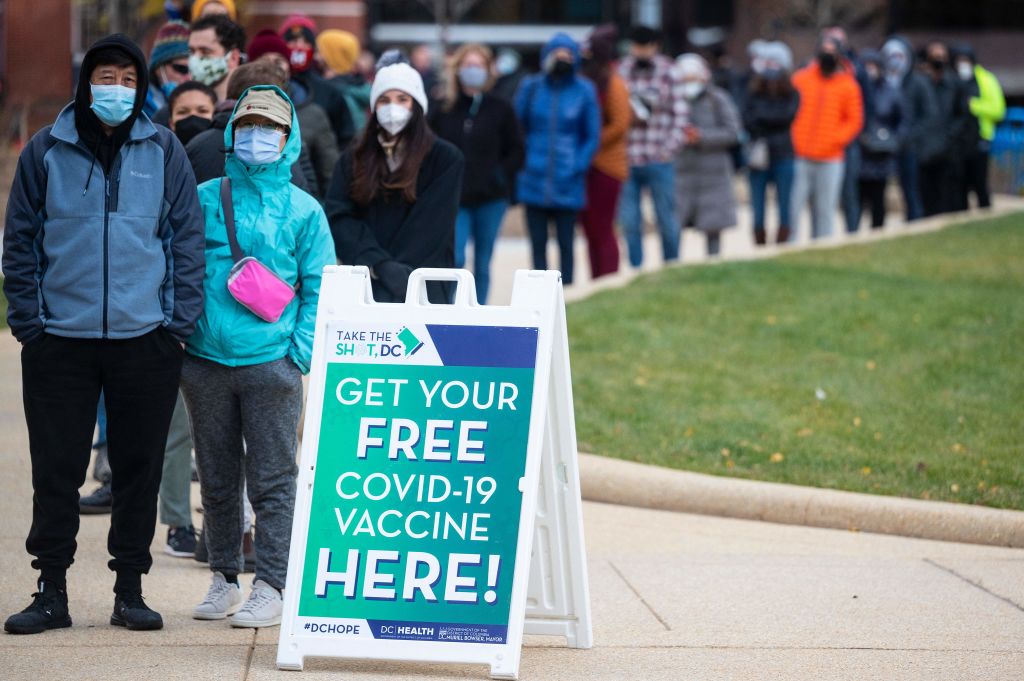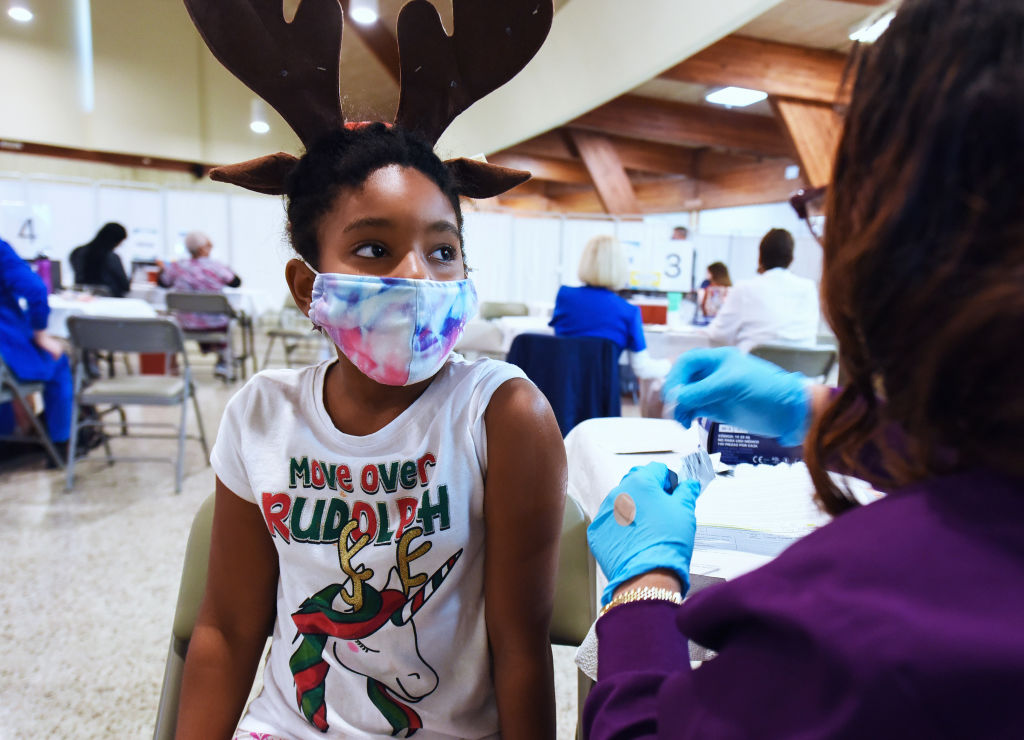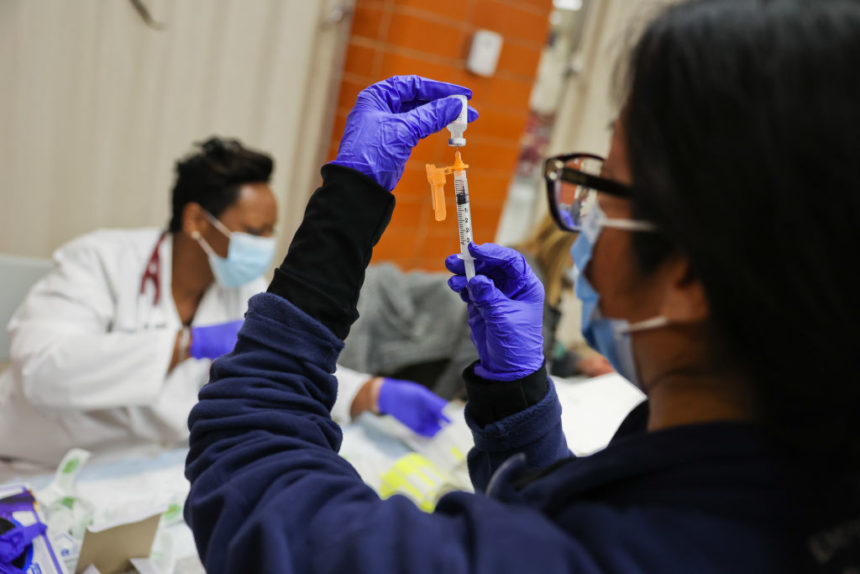A year ago today, 90-year-old Brit Margaret Keenan became the first person in the world to receive a COVID-19 shot as part of the largest immunization campaign in history (8.2 billion doses delivered globally to date). She continues to be a vocal and ardent advocate, the BBC reports.
To celebrate the vaccine’s one-year anniversary, the government rolled out TV and radio ads giving a special push to boosters. Shauna Lewis has details in Campaign, noting that boosters are endearingly known across the pond as “top-up jabs.”
The first American to receive the vaccine, critical care nurse Sandra Lindsay, rolled up her sleeve on December 14. Since then, more than 236 million people in the U.S. have received at least one dose of COVID-19 vaccine. That represents:
• 71.2% of the total population
• 75.7% of the vaccine-eligible population (5 and older)
• 81.6% of everyone 12 and older
• 83.5% of adults
• And (okay, boomers!) 99.9% of seniors 65+
More than 199 million are fully vaccinated: 60% of the total population, 69.8% of everyone 12 and older, 71.6% of adults and 86.6% of seniors. And nearly 48 million have had a COVID-19 booster—26% of adults and 48% of seniors.
A notable exception to the above, the Centers for Disease Control and Prevention points out, is the 35% rate of vaccination in pregnant individuals. That low figure persists despite the reality that COVID-19 in pregnancy carries a heightened risk for severe disease, ICU admission and ventilator use. Oh, and death.
Bracing for winter winds
Not to be left out of the holiday rush, vaccination sites are notably busier these days. As cases and deaths climb upward again, Delta is still driving the bus but the new Omicron variant is on the road and on the move. In response to this traffic, the White House has unveiled its COVID-19 winter plan:
• Expanding the reach of the booster program to 100 million who are eligible but not yet boosted.
• Setting up family vaccination clinics where adults and children can get their shots and boosters together “in one trusted and convenient location” (community health centers, mobile vaccination clinics, pharmacies).
• Making free at-home COVID-19 virus tests more widely available.
• Increasing the number of “surge response” teams deployed to areas that are hard-hit by the pandemic and suffering shortages of healthcare personnel.
• Encouraging businesses to move ahead voluntarily with vaccination or weekly testing of employees while an OSHA standard compelling the same is hung up in federal court. Kathleen Steele Gaivin offers insights in McKnights Senior Living.
• Making monoclonal antibody treatments and, eventually, antiviral pills readily accessible.
• Stepping up efforts to help vaccinate the rest of the world.
• Accelerating the development of new vaccines and treatments.
Along the way, the CDC has tightened requirements for testing all airline passengers traveling to the U.S. from abroad, effective this past Monday. Everyone heading this way must have a negative test the day before boarding their flight. This includes the vaccinated and unvaccinated and U.S. citizens returning home as well as folks visiting from other countries. The CDC recommends that all travelers get tested again three to five days after arriving and that unvaccinated travelers quarantine for seven days.
The CDC also advises healthcare providers to take a travel history for any suspected or confirmed cases of COVID-19, Diana Ernst reports in MPR. HCPs should notify their local health department if a confirmed case is associated with international travel in the 14 days before the onset of symptoms.
Mask requirements for people traveling by public bus, train and air, which were due to expire in January, have been extended through March 18. The fines for noncompliance have doubled to a minimum of $500, and up to $3,000 for repeat offenders.
The World Health Organization is advising seniors and people with chronic medical conditions (heart disease, cancer, diabetes) who are unvaccinated or do not have proof of prior infection to postpone traveling to areas of high COVID-19 transmission. This caution comes just when folks are starting to feel comfortable moving about once again. On the Sunday after Thanksgiving, 2.45 million people passed through TSA checkpoints at U.S. airports, a pandemic-era high.
The Biden administration has said that measures to contain the pandemic will not include a lockdown. Not so in Germany, where the government is banning the unvaccinated from certain public areas and considering a nationwide vaccination mandate. Angela Merkel, stepping down today after 16 years as chancellor, said the death toll “is so bitter because it is avoidable. With the effective and safe vaccines, we have the key to this in our hands.”
On the good news front—it’s there if you look for it—the WHO asserted that health measures to fend off Delta, such as vaccinating, boosting, masking and physical distancing, should also help fight Omicron. Stephen Massey, managing director of the Health Action Alliance, calls on businesses to double down on these basic safety measures. “Taking action now can slow the virus’ spread,” he says. “There is no reward for inaction.”

The communications effort presses on
• The emergence of Omicron is challenging corporate communications professionals to pivot, not panic, and draw upon best practices developed over the past two years, Chris Daniels writes in PRWeek. Kate Bullinger, CEO of Weber Shandwick’s management consultancy United Minds, says it means “closely following evolving science and CDC guidelines, communicating often and with transparency, monitoring employee sentiment and prioritizing the safety of the workforce.”
• In MM+ M, Lecia Bushak explores the Omicron messaging dilemma for healthcare communicators: How to express sufficient concern about the latest variant without overly fretting. Some experts, including Dr. Amesh Adalja, senior scholar at the Johns Hopkins Center for Health Security, feel that communication has been poor and that the core message is lost in the sauce. “It’s not the lack of boosters that make Omicron a threat,” he says. “It’s the unvaccinated who make it a threat.”
• Will 2022 bring an endgame to the pandemic? Marketers are making no assumptions, Larry Luxner notes in MM+M. “If we’ve learned anything from this, it’s to plan for the unplanned and be prepared to pivot,” said Heidi Arthur, chief campaign development officer at the Ad Council. “It continues to be important to answer the questions on people’s minds and normalize the whole notion of having questions.” Elyse Margolis, group president at Real Chemistry, observes that “We’ve never lived in such a big clinical trial involving the whole world. Intelligent people will continue to have questions.”
• A TV ad for British supermarket chain Tesco, in which Santa cheerfully shows his vaccine passport, was not coercive and did not encourage medical discrimination against the unvaccinated, the Advertising Standards Authority has concluded. As Imogen Watson reports in Campaign, the ad generated more than 5,000 complaints, second most in the Authority’s history.
• The Department of Health and Human Services will launch new ads and events encouraging adults to get their boosters ASAP. HHS will also partner with AARP to present virtual town halls and offer rides to vaccination sites.
• The Centers for Medicare and Medicaid Services is sending letters to the 63 million people enrolled in Medicare, explaining how to get boosters. The agency will make use of email and social media channels while expanding its outreach to health plans and nursing homes.
• Medicaid will reimburse HCPs for providing COVID-19 counseling visits for families, answering their questions and emphasizing the importance of vaccinating children. Medicaid covers 40% of all children in the U.S. and is a “significant source” of coverage for Black and Brown children.
• The American Academy of Pediatrics and PatientPoint are collaborating on a series of educational videos about COVID-19 vaccines for children, Larry Dobrow reports in MM+M. The videos, for use in pediatricians’ offices, cover such topics as preparing for the shot, potential side effects and interactions with other childhood immunizations.
The mandate mambo dances on
• In his last month in office, New York City Mayor Bill de Blasio has announced a vaccination mandate applying to all private employers, the first of its kind in the nation, effective December 27.
• A federal court in Georgia on Tuesday pushed the pause button on the vaccine mandate for federal contractors nationwide. The deadline for fully vaccinated compliance was recently postponed to January 18.
• Assisted living facilities are caught in a doughnut hole of uncertainty, Kimberly Bonvissuto reports in McKnights Senior Living. At least for now, assisted living is not subject to the CMS vaccination mandate for healthcare workers or the OSHA standard for private businesses on vaccination and testing. Both are in a state of suspended animation as challenges ricochet in federal courts. In an understatement, one long-term care leader called the situation “dynamic.”
• Addus Home Care, based in Frisco, Texas, has 33,000 employees in 200 locations across the U.S. About 90% of its home healthcare workers and 80% of hospice staff are fully vaccinated, but only 63% of personal care employees. The notable exception is New York, where a state mandate has prompted 95% of Addus workers to receive their shots. Diane Eastabrook offers details in McKnights Home Care.
• Not quite a mandate but leverage nonetheless: Nevada is planning to impose an insurance surcharge of up to $55 a month for unvaccinated state employees. The surcharge will help cover the cost of testing the unvaccinated; the state has been picking up the tab, which hit $3.3 million in one year.
• How do employees feel about vaccination mandates? In MM+M, Larry Dobrow finds a tossed salad of results in a survey by The Harris Poll and Fast Company. More than one-third (35%) are more likely to accept a job offer from an employer with a vaccination mandate, but nearly one in five (19%) are less likely to do so. “However you read it, it’s a mess,” Dobrow says.
• In California, New Jersey and other states, parents who object to vaccination mandates for their children are protesting by leaving hundreds of pairs of shoes outside schools. The idea is to symbolize the children who won’t be attending class in person if mandates are enforced.

The vaccine dashboard
• Pfizer may have data on vaccination of children under 5 years of age before the end of the year. Trials are underway in children ages 2 to 5 years and 6 months to 2 years. The White House has pledged to support “timely review” of applications for this youngest age group.
• The European Medicines Agency has recommended approval of the Pfizer/BioNTech COVID-19 vaccine for children ages 5 to 11.
• The EMA has also begun a rolling review of Valneva’s COVID-19 vaccine. The company says its technology platform is adaptable to handle new variants.
• J&J’s COVID-19 vaccine has gained its first major regulatory approval (i.e., not just emergency use) from Health Canada.
The rest
• The FDA has authorized the use of the monoclonal antibody cocktail of bamlanivimab and etesevimab (Lilly) for treatment and post-exposure prevention of COVID-19 in young children, including newborns. The combination was previously approved for patients ages 12 and older. Brian Park does a deeper dive into the data in MPR.
• A nursing director at a South Carolina nursing home faces federal charges of making fake COVID-19 vaccination cards, Danielle Brown reports in McKnights Long-Term Care News.
• With oral antiviral pills soon to be available for treating COVID-19, what impact will they have in treatment? Dr. Erica Johnson, assistant professor of medicine at Johns Hopkins and chair of the American Board of Internal Medicine’s Infectious Disease Board, offers expert insights in an interview with Infectious Disease Advisor’s Devon Cimino.
• The Philadelphia Union, missing six starters and 11 players overall due to COVID-19 protocols, lost to the New York City Football Club 2-1 in Major League Soccer’s Eastern Conference Championship.
• Two hippos that were “expelling snot” at a zoo in Belgium have tested positive for SARS-CoV-2, the Washington Post reports.
• Omicron is the name of a death metal band in Belgium.
Parting shot
We’re not sure how to characterize the Omicron variant, so we are calling it “worrisome.” That’s about right: it’s certainly capable of causing some worry. The question is, how much? We can’t forget that Delta remains responsible for the current casualties, lately tallying over 1,100 deaths and more than 117,000 cases a day.
COVID has brought us a world of worry for nearly two years now, and Omicron is causing high anxiety just when we were looking forward to an angst break at the holidays. “Each setback in the battle against the pandemic takes an added emotional and mental toll on employees and makes it more challenging to motivate people and keep optimism high,” says United Minds CEO Kate Bullinger.
With that perspective in mind, companies should continue to make mental health and wellness a priority in their in-house communications. Recommended reading: Jon Nelson’s recent piece for MM+M, “I’m a medical marketing professional who suffers from mental illness.” Recommended listening: Nelson’s podcast conversation with MM+M editor-in-chief Larry Dobrow.
…and some songs
December (full album), George Winston
Get Me Through December, Allison Krauss and Natalie MacMaster
December Snow, The Moody Blues
Back to December, Taylor Swift
Thanks so much for joining us. Back next Wednesday with more. Be safe and boost your chances of staying well through the holidays.








